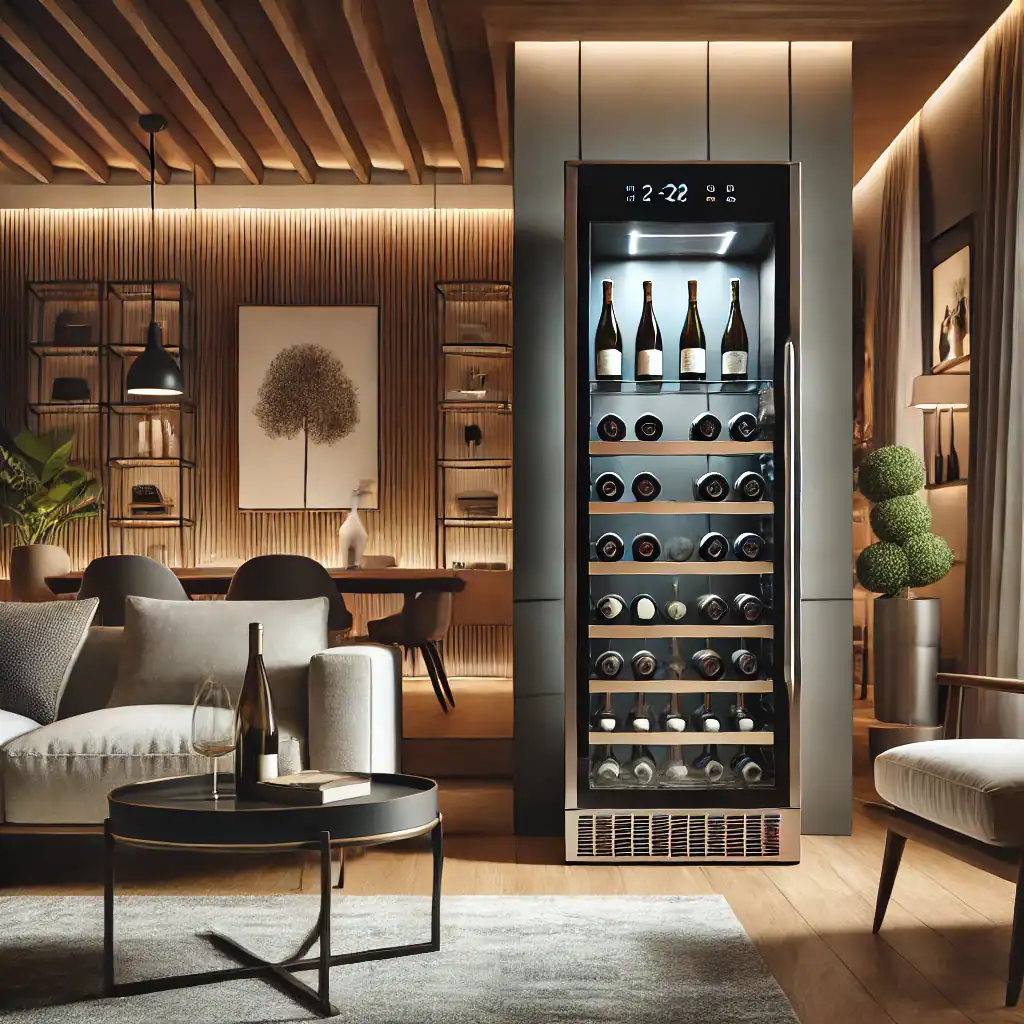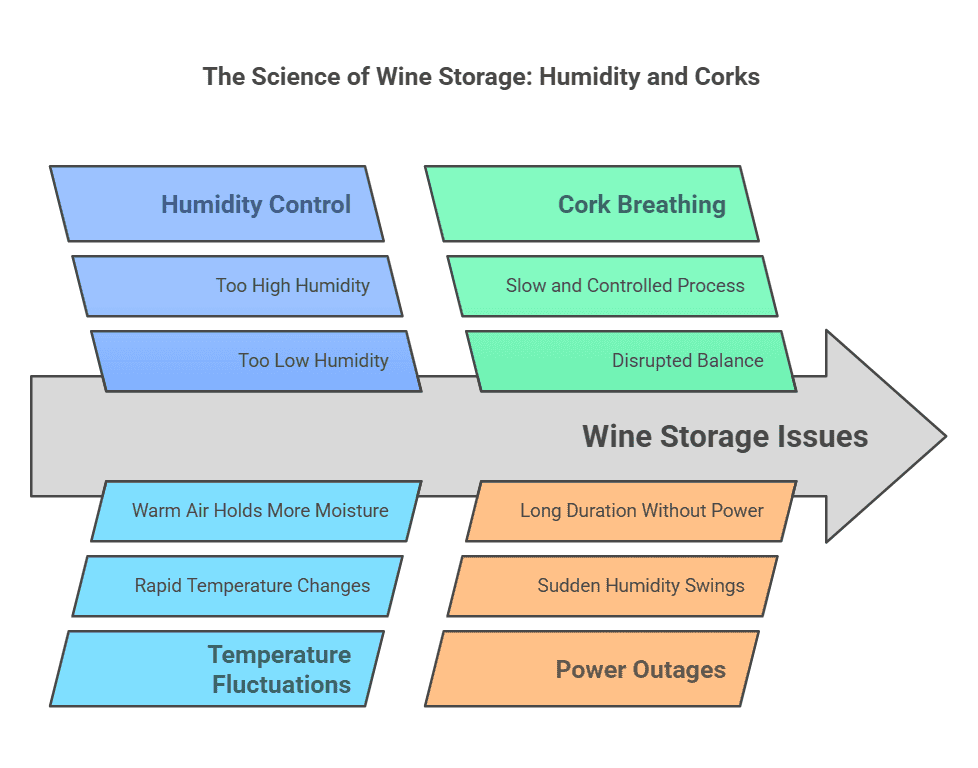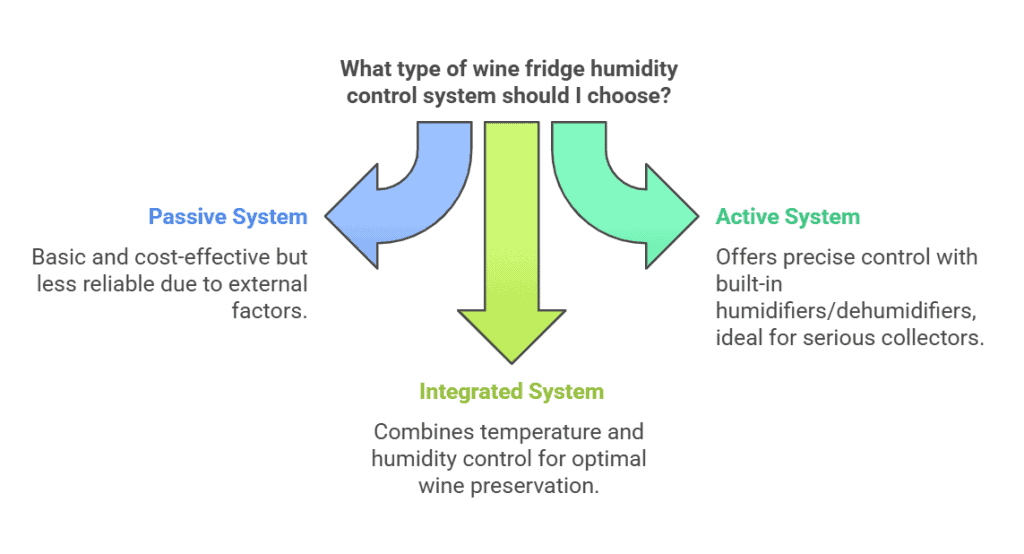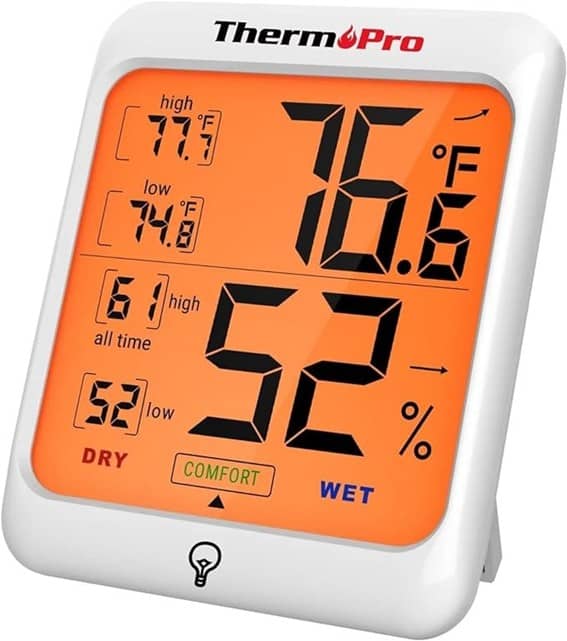Did you know that improper humidity levels can destroy a $10,000 wine collection in just months?
I’ve seen it happen, and it’s heartbreaking! As a wine enthusiast and storage specialist, I can’t stress enough how crucial proper humidity control is for preserving your precious wines.
Today, we’ll dive deep into the world of wine fridge humidity control, exploring everything from optimal levels to practical solutions for common problems.
Whether you’re a seasoned collector or just starting your wine journey, understanding humidity control is essential for protecting your investment and ensuring your wines age gracefully.
Welcome to Didi Somm, and Cheers!
Important Notice: The information in this article is for general and public information purposes only. It solely reflects Didi Somm’s or his Staff’s opinion, and no responsibility can be assumed for errors or omissions in the service’s contents. For details, please check the Disclaimer at the bottom of the homepage.

Key Takeaways
- Optimal wine storage humidity ranges from 60% to 70% RH (Relative Humidity)
- Proper humidity control prevents cork damage and wine spoilage
- Modern wine fridges feature advanced humidity management systems
- Regular monitoring and maintenance are crucial for optimal performance
- Both too high and too low humidity can damage your wine collection
- Investment in quality humidity control systems pays off in wine preservation
The Science Behind Wine Storage Humidity
Let me tell you something that blew my mind when I first started collecting wine – it’s not just about keeping your bottles cool!
I learned this lesson the hard way when I found several of my prized bottles had leaked after storing them in my regular basement fridge. Here’s the deal: relative humidity (RH) is absolutely crucial for wine storage, and the science behind it is fascinating.
Think of your wine cork as a tiny, sophisticated moisture regulator. When I explain this to my wine club members, I often use the sponge analogy. A cork is like a natural sponge that needs just the right amount of moisture to maintain its shape and elasticity. Too little moisture, and it shrinks – trust me, I lost a $200 bottle of Bordeaux learning that lesson! Too much, and you’re inviting mold to your wine party.
The relationship between temperature and humidity in wine storage is like a perfectly choreographed dance. When I installed my first proper wine fridge, I noticed how temperature changes would cause humidity fluctuations. It’s basic physics – warmer air holds more moisture than cooler air. That’s why you’ll sometimes see condensation forming when temperatures shift too quickly.
Speaking of moisture transfer, this is where things get really interesting. Through years of storing different wines, I’ve observed how corks actually “breathe.” They allow minuscule amounts of air to interact with the wine, which is essential for aging. But this process needs to be incredibly slow and controlled. When humidity levels are off, this delicate balance gets disrupted.
One particularly memorable incident taught me just how significant humidity fluctuations can be. Last summer, during a power outage, my backup generator failed, and my wine fridge went offline for 48 hours. The humidity levels went haywire, swinging from 45% to 85%. While most wines survived, I noticed subtle changes in a few bottles months later – the corks had slightly protruded, and the wine just didn’t taste quite right.

Affiliate Disclaimer: This page may include Affiliate links, meaning that we get a commission if you decide to purchase through this site at no extra cost to you. Please read our Disclaimer for your info.
Optimal Humidity Levels for Wine Storage
After 15 years of storing wine, I can tell you that finding the sweet spot for humidity is crucial. The industry standard isn’t just a random number – it’s based on decades of research and experience. I keep my wine fridge at 65% relative humidity, right in the middle of the ideal 60-70% range. And let me tell you, it makes a difference!
Different wines actually have slightly different humidity preferences, which is something I discovered through trial and error. My older vintage reds seem to do best at around 65-68% humidity, while my whites are happy at 60-65%. The thickness of the cork and the wine’s age play a big role in this. I learned this after noticing how differently my French and California wines responded to various humidity levels.
Seasonal changes can really throw a wrench in your humidity management plans. I remember my first summer as a collector – the humidity in my wine fridge kept creeping up as the outside humidity increased. Now I know to adjust my settings seasonally. During humid summers, I might need to run a dehumidifier near my wine fridge, while winters often require a bit of extra humidity.
When it comes to monitoring humidity levels, I’m a bit obsessive – but with good reason! I use a calibrated digital hygrometer that I check daily, and I keep a log of the readings. This might sound like overkill, but it has saved my collection more than once. I caught a failing humidity control system early just because I noticed a pattern of unusual readings.
The signs of improper humidity are subtle but important to catch early. Low humidity shows up as dried-out corks and slight seepage, while high humidity can lead to label damage and that dreaded musty smell. I once ignored some early warning signs – slightly sticky bottles and condensation – and ended up with a mold issue that could have been prevented.
| Aspect | Details |
|---|
| Ideal Humidity Range | 60-70% relative humidity is recommended for optimal wine preservation. |
| Vintage Reds | Prefer 65-68% humidity; factors include cork thickness and wine age. |
| White Wines | Thrive at 60-65% humidity; responses vary based on origin. |
| Seasonal Adjustments | Monitor and adjust for humidity fluctuations due to seasonal changes. |
| Monitoring Methods | Use a calibrated digital hygrometer, check daily, and maintain a log. |
| Signs of Low Humidity | Dried-out corks, slight seepage. |
| Signs of High Humidity | Label damage, musty smell, mold risk. |
Wine Fridge Humidity Control Systems
After experimenting with various wine storage solutions over the years, I’ve become quite familiar with different humidity control mechanisms. My first wine fridge was a basic model with passive humidity control – basically just a water tray at the bottom. While it worked okay for my small collection back then, I quickly learned why serious collectors invest in active humidity control systems.
The difference between active and passive systems is like night and day. My passive system was constantly affected by door openings and ambient conditions. But when I upgraded to an active system with a built-in humidifier and dehumidifier, it was like putting my wine collection on autopilot. The system maintains steady humidity levels regardless of external conditions.
Modern wine fridges have some pretty impressive features. My current unit uses smart sensors that can detect even minor humidity fluctuations and adjust accordingly. It’s amazing how far the technology has come – I remember when we had to manually add water to trays! Now, my system even sends alerts to my phone if the humidity strays from the optimal range.
I’ve tested various humidity control technologies over the years, from basic water pans to advanced electronic systems. The most reliable setup I’ve found combines a thermoelectric cooling system with an integrated humidity control unit. It’s more expensive upfront, but the precise control it offers is worth every penny when you’re protecting valuable wines.
The integration of temperature and humidity control is crucial – they’re two sides of the same coin. My current system manages both simultaneously, which prevents the issues I used to have with my older units where adjusting one would throw off the other. It’s like having a sophisticated climate control system specifically designed for wine.

Common Humidity Control Problems and Solutions
Let me share some real-world experience with humidity control issues – I’ve seen it all! Early detection is absolutely crucial.
I learned this the hard way when I ignored some minor condensation on my wine bottles, thinking it was normal. Spoiler alert: it wasn’t! Now I know that even small signs like slight label warping or cork protrusion can indicate bigger problems brewing.
System Failures
System failures can be tricky to diagnose, but I’ve developed a pretty solid troubleshooting approach. First, I check the door seals – they’re often the culprit. Then I look at the water reservoir (if there is one) and the drainage system. Last month, I thought my humidity control was failing, but it turned out to be just a clogged drain line. A quick cleaning fixed the issue!
Condensation Management
Condensation management has been one of my biggest challenges. I’ve found that proper air circulation is key. I installed a small fan in my larger wine fridge to help distribute the air more evenly, and it made a huge difference in preventing those annoying water droplets from forming on the bottles and walls.
Environmental Factors
Environmental factors can really throw your humidity control for a loop. My wine fridge sits in my basement, and I noticed significant humidity fluctuations during rainy seasons. The solution? I installed a dehumidifier in the basement itself to create a more stable environment around the wine fridge. It works like a charm!
Emergencies – Backup
For emergency situations, I always keep a backup plan ready. This includes a battery-powered hygrometer, moisture-absorbing packets, and a small portable humidifier/dehumidifier. When my main system failed during a power outage last year, these backup measures helped maintain acceptable humidity levels until repairs could be made.
Maintaining Proper Humidity Levels
Regular maintenance is the secret sauce to keeping your wine fridge running perfectly. I’ve developed a monthly checklist that’s saved me from countless potential problems. Every first Sunday of the month, I clean the condensation tray, check all seals, and calibrate my hygrometers. It takes about 30 minutes, but it’s time well spent!
I’ve learned that successful humidity monitoring is all about consistency and attention to detail. I keep a digital log of daily humidity readings – it might seem excessive, but it’s helped me spot trends and potential issues before they become problems. Plus, some of my wine-collecting friends have started doing the same after seeing how useful it is.
Calibrating sensors is something many collectors overlook, but it’s super important. Every three months, I use a salt calibration test on my hygrometers. It’s a simple process: create a saturated salt solution in a sealed container with the hygrometer, and it should read 75% humidity after a few hours. If it’s off, I know it’s time for an adjustment or replacement.
Seasonal maintenance is crucial – different seasons bring different challenges. In winter, I pay extra attention to humidity levels because heating systems can dry out the air. During summer, I’m more focused on preventing condensation due to higher ambient humidity. I’ve learned to adjust my maintenance routine based on these seasonal patterns.
Sometimes, you just need to call in the pros. I have my wine fridge serviced annually by a certified technician. Yes, it costs a bit more than DIY maintenance, but they catch things I might miss. Last year, they identified a small seal leak that could have caused major humidity problems if left unchecked.
| Aspect | Details |
|---|
| Regular Maintenance | Develop a monthly checklist: Clean condensation tray, inspect seals and calibrate hygrometers. This routine takes about 30 minutes and prevents potential issues. |
| Consistent Monitoring | Keep a digital log of daily humidity readings to identify trends and address issues proactively. This practice enhances the longevity of your wine collection. |
| Sensor Calibration | Every three months, perform a salt calibration test on hygrometers: Create a saturated salt solution in a sealed container with the hygrometer; it should read 75% humidity after a few hours. |
| Seasonal Adjustments | Adapt maintenance routines to seasonal changes: In winter, monitor for dryness due to heating systems. In summer, prevent condensation from higher ambient humidity. |
| Professional Servicing | Schedule annual servicing by a certified technician to detect and resolve issues beyond routine maintenance, ensuring optimal performance of your wine storage system. |
Upgrading Your Wine Fridge Humidity Control
After years of collecting wine, I’ve learned that knowing when to upgrade your humidity control system is crucial. It’s not just about age – it’s about performance. When my old system started struggling to maintain consistent humidity levels, especially during summer months, I knew it was time for an upgrade. The decision paid off tremendously in terms of wine preservation and peace of mind.
The latest innovations in humidity control technology are pretty amazing. My new system uses AI-driven sensors that predict humidity fluctuations before they happen. It’s like having a weather station specifically for my wine collection! The system even sends alerts to my phone when conditions start to drift from optimal levels, which has saved my collection more than once during power outages.
When it comes to cost-benefit analysis, I always tell fellow collectors to think long-term. Sure, a high-end humidity control system might cost more upfront, but I’ve learned that cheaper solutions often end up being more expensive in the long run. I once tried to save money with a budget system and ended up spending more on replacements and repairs within just two years.
The professional versus DIY installation debate is one I’m quite familiar with. While I’m pretty handy with tools, I opted for professional installation of my current system. The technician spotted potential issues I wouldn’t have noticed and optimized the setup for my specific space. However, I do handle some basic maintenance tasks myself, like cleaning and monitoring.
Looking toward the future, I’ve made sure my current setup is expandable. I chose a modular system that can be upgraded as new technology becomes available. This approach has already paid off – last year, I was able to add a smart monitoring module without replacing the entire unit. Wine collecting is a long-term hobby, and your storage solution should be able to grow with your collection.

FAQs – Wine Fridge Humidity Control
- What is the ideal humidity level for wine storage? The ideal humidity level for wine storage is between 60% and 70% relative humidity (RH), with 65% being optimal for most wines.
- Can low humidity damage wine? Yes, low humidity can cause corks to dry out and shrink, leading to wine oxidation and spoilage due to air entering the bottle.
- What happens if wine fridge humidity is too high? Excessive humidity can promote mold growth, damage labels, and potentially compromise the integrity of the storage unit itself.
- How often should I check wine fridge humidity levels? Monitor humidity levels at least weekly, or daily if you have a valuable collection or live in an area with significant climate variations.
- Do all wine fridges have humidity control? Not all wine fridges have built-in humidity control. Higher-end models typically offer this feature, while budget options may require supplemental humidity management.
- How can I increase humidity in my wine fridge? You can increase humidity by adding water trays, using humidity beads, or installing a dedicated humidification system.
- What’s the difference between active and passive humidity control? Active control uses mechanical systems to maintain humidity levels, while passive systems rely on natural moisture exchange and basic design features.
- Should I be concerned about condensation in my wine fridge? Some condensation is normal, but excessive condensation can indicate problems with temperature regulation or seal integrity.
- How do seasonal changes affect wine fridge humidity? Seasonal changes can significantly impact humidity levels, requiring adjustments to control systems and more frequent monitoring.
- What are humidity beads, and how do they work? Humidity beads are specially designed materials that absorb and release moisture to help maintain consistent humidity levels.
- Can I use a regular hygrometer in my wine fridge? While possible, it’s better to use a calibrated wine storage hygrometer for accurate readings in the specific conditions of a wine fridge.
- How long do humidity control systems typically last? Quality humidity control systems can last 5-10 years with proper maintenance, though components may need replacement sooner.
- What’s the relationship between temperature and humidity in wine storage? Temperature and humidity are interdependent; changes in one typically affect the other, requiring balanced control of both factors.
- Are there smart humidity control systems available? Yes, many modern wine fridges offer smart humidity control with remote monitoring and automatic adjustments.
- How much should I invest in humidity control? The investment should be proportional to your collection’s value; generally, spend 5-10% of your collection’s worth on proper storage.
Conclusion
Mastering wine fridge humidity control is essential for preserving your wine collection’s quality and value.
By understanding the principles we’ve covered and implementing proper monitoring and maintenance practices, you can ensure your wines age perfectly in optimal conditions. From my experience, investing in quality humidity control is investing in the future of your wine collection.
Are you ready to upgrade your wine storage system? – I hope you got useful tips and inspiration from the above article.
Enjoy your precious wine collection and Cheers!
For your reference, the latest articles by Didi Somm include:
- Wine Storage Humidity – All You Need To Know
- Wine Cork Types: Best Expert Advice For You
- Wine Fridge Troubleshooting: Best Expert Advice For You
- Wine Fridge Capacity: Get the Best Advice To Store Wine Bottles
- Best Wine Refrigerators For Aging – Your Expert Guide For 2025
- Top 3 Thermoelectric Wine Coolers – Best Expert Guide For You
Important Notice: The information in this article is for general and public information purposes only. It solely reflects Didi Somm’s or his Staff’s opinion, and no responsibility can be assumed for errors or omissions in the service’s contents. For details, please check the Disclaimer at the bottom of the homepage.




